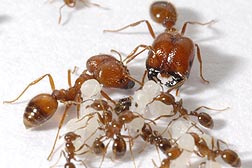Fire Ants Are No Match for Poison Frogs
Since its accidental introduction into the United States from South America in the 1930s, the red imported fire ant, Solenopsis invicta, has spread throughout the southern United States, decimating small-animal populations, damaging crops and other plants, and inflicting painful and sometimes lethal venomous stings on humans and livestock. Scientists are constantly looking for effective methods to control this pest.
Robert Vander Meer, research leader in the Imported Fire Ant and Household Insects Unit at the Agricultural Research Service’s Center for Medical, Agricultural, and Veterinary Entomology in Gainesville, Florida, partnered with other researchers to determine whether toxic alkaloids from the brilliantly colored skin of poison frogs would deter fire ants.
Toxic alkaloids—naturally occurring compounds—on the skin of these frogs were discovered in the early 1960s in Central and South America. However, Amerindian tribes had discovered the effects of the alkaloids long before then, when they learned how to secure alkaloid secretions from the skin of poison frogs of one genus to make poison darts for hunting. Poison frogs do not naturally produce the alkaloids, but instead sequester them by ingesting millipedes, ants, mites, and other arthropods that do produce the alkaloids.
Vander Meer’s collaborators include engineer Cliff Hoffman at ARS’s Southern Plains Agricultural Research Center in College Station, Texas; chemical ecologist Paul Weldon at the Smithsonian Conservation Biology Institute at the National Zoological Park in Front Royal, Virginia; and chemist Thomas F. Spande at the National Institutes of Health (NIH) in Bethesda, Maryland.
|
|
“After finding that the frogs had unique alkaloids, NIH scientist John Daly, now deceased, began exploring possible medical applications of the compounds,” Vander Meer says. “Over the years, scientists have identified and isolated about 900 alkaloids from the skin of poison frogs.”
Traditionally, the frogs’ coloration and alkaloids were thought to be used as protection against mammals and birds, not as defenses against arthropods like ants, he says. However, these frogs could be fair game for many aggressive, predacious ant species in Central and South America, such as fire ants.
Vander Meer and his team developed a way to measure the toxicity of 20 poison-frog alkaloids, most of which were purified from frog-skin extracts that Daly had collected and prepared. Not all of the alkaloids deterred fire ants at concentrations that would be found in nature, but some were highly effective.
In Central America, the tropical fire ant, S. geminata, occupies the same territory as the poison dart frog, Oophaga pumilio, Vander Meer says. The major alkaloid produced by S. geminata is found on the skin of O. pumilio, showing that this frog eats S. geminata ants. However, the bioassay showed that this alkaloid was not very effective against S. invicta.
“Interestingly, this same frog has a varied diet of ants and mites,” he says. “Mite-derived alkaloids have also been reported on O. pumilio’s skin, and these compounds were found to be highly effective at incapacitating S. invicta.”
The varied frog diet appears to protect the frogs from ant predation, he adds. This supports the observation that poison frogs are not attacked by predatory ants in their natural habitat, but if the frogs are raised on a diet that does not contain alkaloids, they are readily attacked when exposed to ants.
“Once the frogs get these alkaloids into their systems, they may modify some of the compounds,” Vander Meer says. “Without those starting materials from the arthropods, they cannot produce the alkaloids.”
This study, which was published in Naturwissenschaften in January 2013, broadens the use of these alkaloids by poison frogs to include protection against ant predation.
In earlier work, published in Proceedings of the National Academy of Sciences, Weldon collaborated with scientists at ARS and NIH to test poison-frog alkaloids against the yellowfever mosquito. They found pumiliotoxin 251D to be the most potent of the ones tested. When mosquitoes landed on surfaces treated with this alkaloid, they were unable to fly, and they died. After testing chemical structures related to 251D, the researchers determined that the natural 251D structure was 10 times more potent than the others.
The discovery that pumiliotoxin 251D and other poison-frog alkaloids act on contact with arthropods (fire ants and mosquitoes) was significant, Weldon says. “Previous studies with pumiliotoxin 251D focused on injecting it into test insects—tobacco hornworms. By injecting it, they missed the most remarkable property of this compound—its ability to act as a contact toxin, penetrating the surface of the insect.”
“Disease transmission by mosquitoes is on the rise worldwide and is an extremely important problem” Vander Meer says. “Derivatives of these frog alkaloids may be useful in the future because when they are applied to surfaces, mosquitoes that land there die—preventing them from biting and transmitting disease.”
The main concern is the high toxicity of pumiliotoxin 251D. However, other alkaloids identified from frogs or derivatives of the alkaloids may have greater mosquito toxicity and less mammalian toxicity, scientists suggest. Further research is needed to find compounds that maintain the desirable effects of the alkaloids while reducing their toxicity.—By Sandra Avant, Agricultural Research Service Information Staff.
This research is part of Veterinary, Medical, and Urban Entomology, an ARS national program (#104) described at www.nps.ars.usda.gov.
To reach scientists mentioned in this article, contact Sandra Avant, USDA-ARS Information Staff, 5601 Sunnyside Ave., Beltsville, MD 20705-5128; (301) 504-1627.
"Fire Ants Are No Match for Poison Frogs" was published in the November/December 2014 issue of Agricultural Research magazine.









